University of Bedfordshire: Medical Tourism Service Quality Project
VerifiedAdded on 2022/01/15
|19
|5514
|143
Project
AI Summary
This Theory into Practice project proposal explores the impacts of service quality within the Indian medical tourism sector, focusing on the relationship between hospitality and medical services. The project aims to evaluate key attributes of service quality, assess customer requirements, and develop strategies to enhance service quality in the industry. The research employs a systematic review methodology, examining existing literature to analyze the factors influencing patient satisfaction and loyalty. The study considers the economic impact of medical tourism, application of transformational leadership, and the use of SERVQUAL scale. The project aims to provide insights into the integration of medical and hospitality services to improve the overall success of the medical tourism sector in India, contributing to the development of strategic frameworks for the industry.
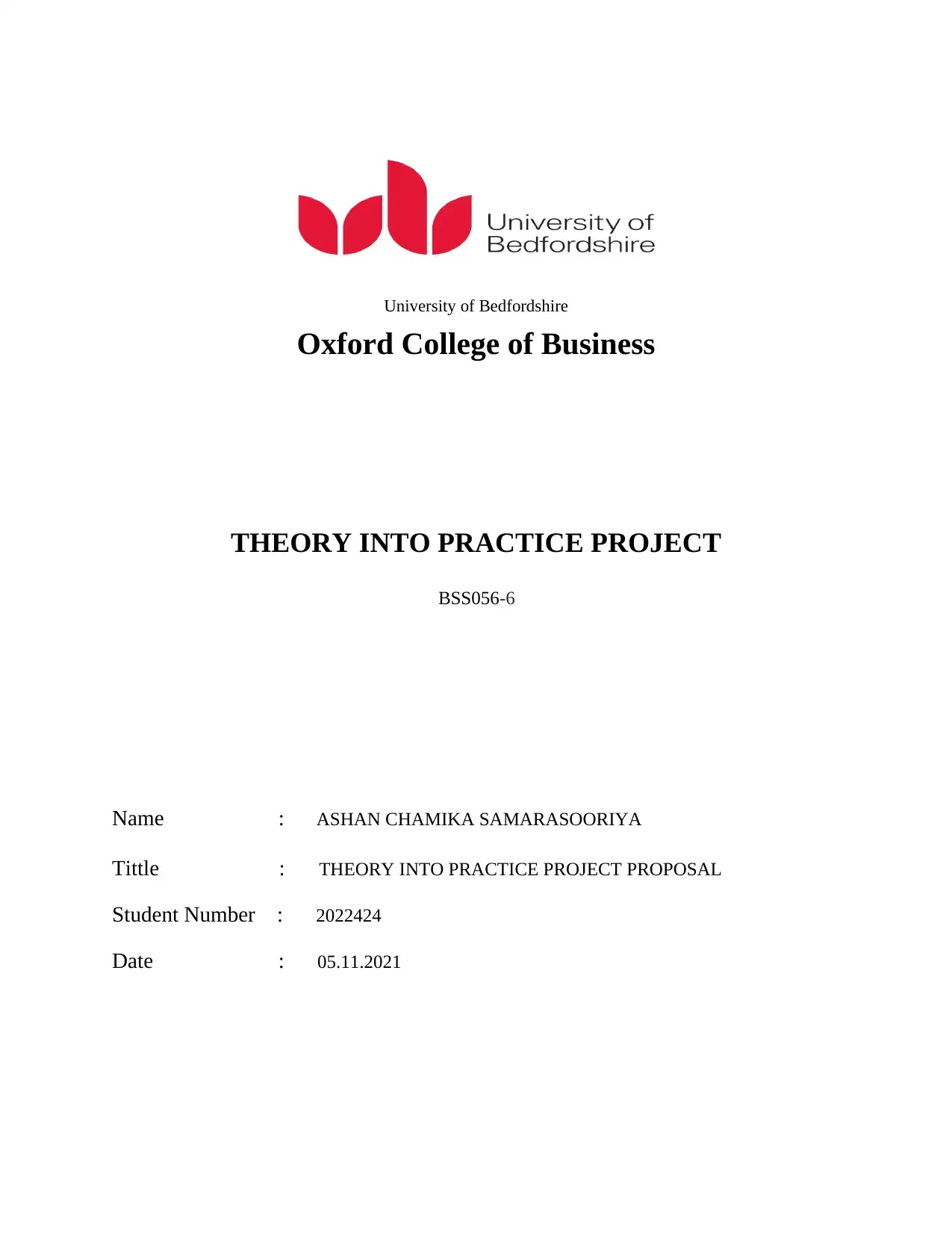
University of Bedfordshire
Oxford College of Business
THEORY INTO PRACTICE PROJECT
BSS056-6
Name : ASHAN CHAMIKA SAMARASOORIYA
Tittle : THEORY INTO PRACTICE PROJECT PROPOSAL
Student Number : 2022424
Date : 05.11.2021
Oxford College of Business
THEORY INTO PRACTICE PROJECT
BSS056-6
Name : ASHAN CHAMIKA SAMARASOORIYA
Tittle : THEORY INTO PRACTICE PROJECT PROPOSAL
Student Number : 2022424
Date : 05.11.2021
Paraphrase This Document
Need a fresh take? Get an instant paraphrase of this document with our AI Paraphraser
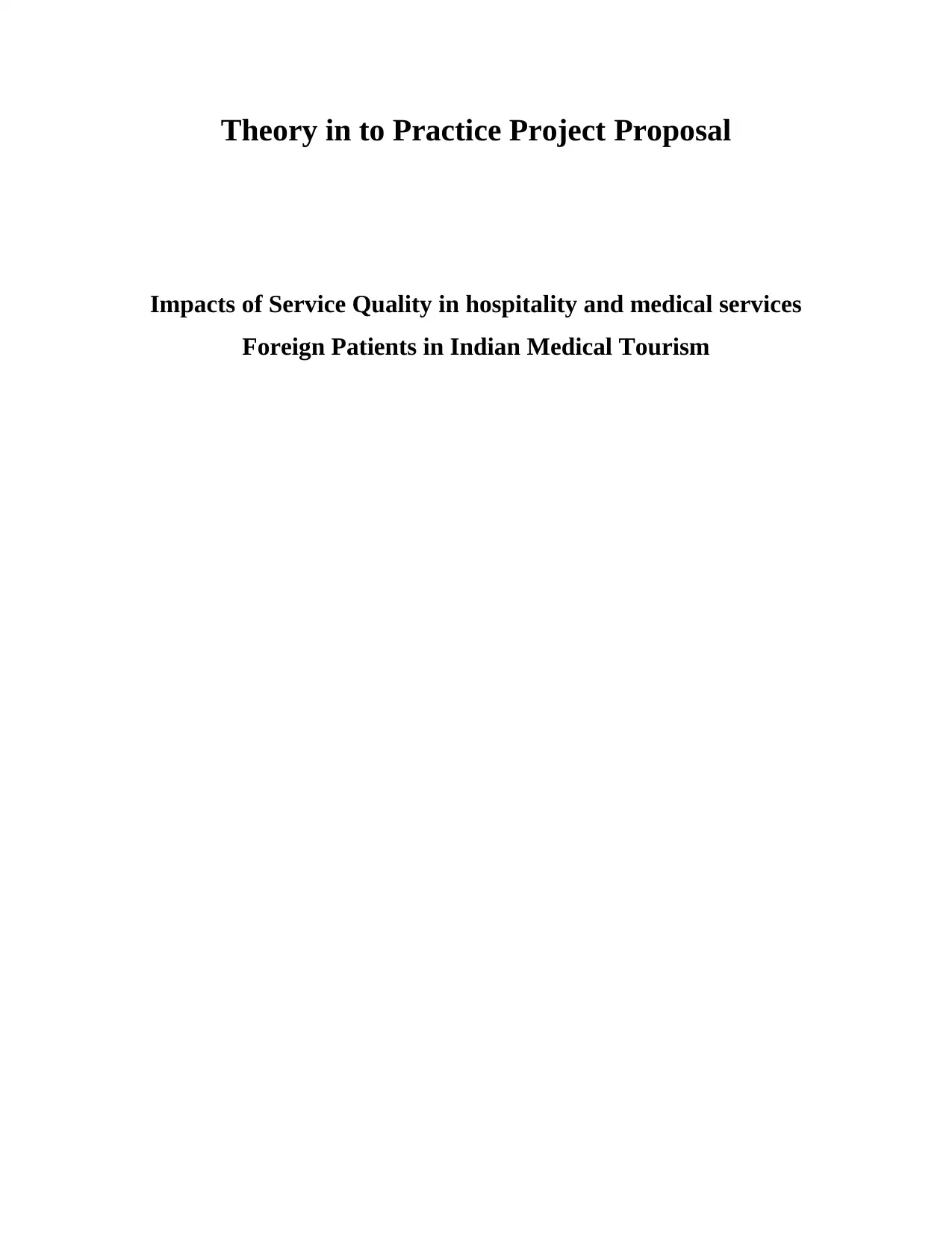
Theory in to Practice Project Proposal
Impacts of Service Quality in hospitality and medical services
Foreign Patients in Indian Medical Tourism
Impacts of Service Quality in hospitality and medical services
Foreign Patients in Indian Medical Tourism
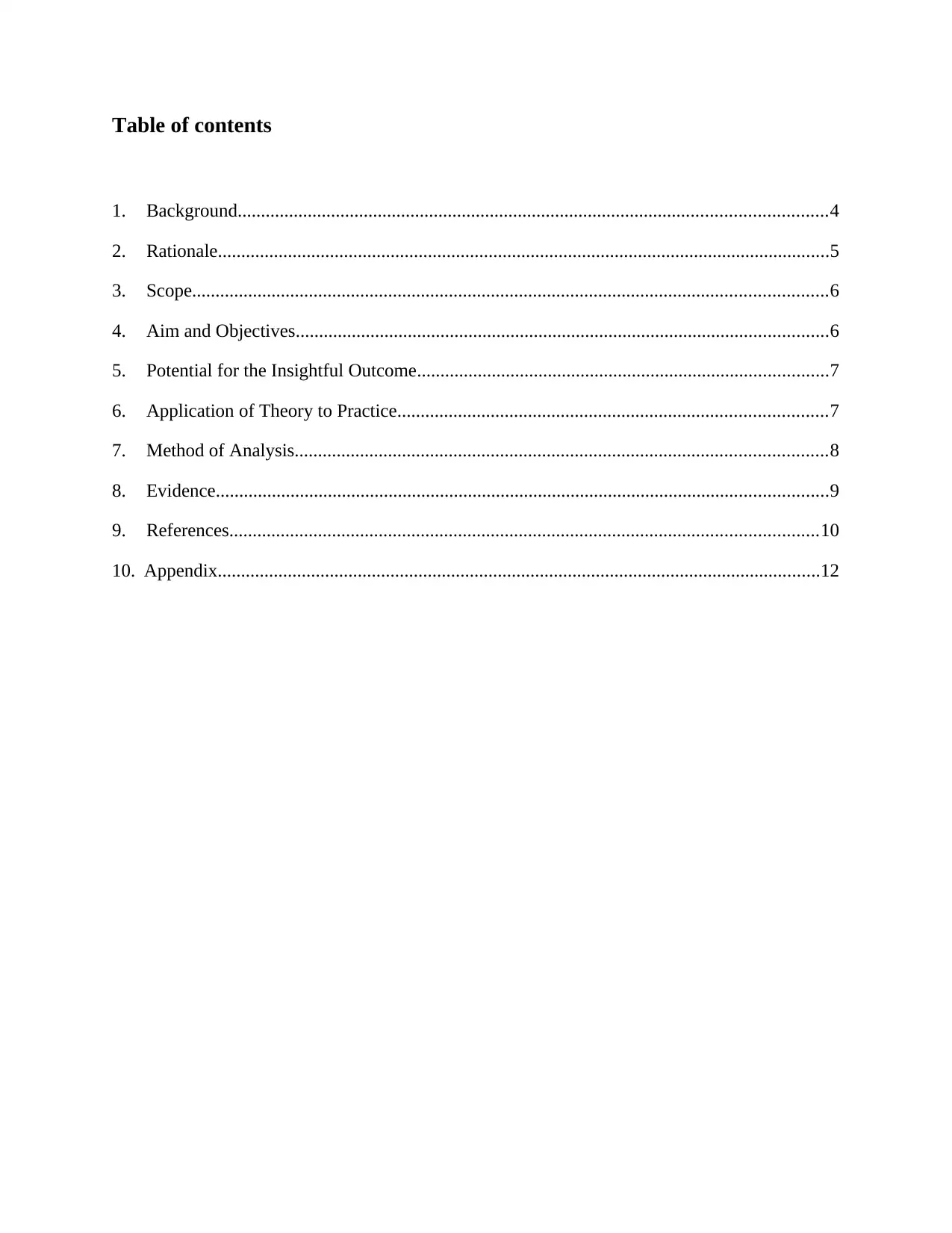
Table of contents
1. Background..............................................................................................................................4
2. Rationale...................................................................................................................................5
3. Scope........................................................................................................................................6
4. Aim and Objectives..................................................................................................................6
5. Potential for the Insightful Outcome........................................................................................7
6. Application of Theory to Practice............................................................................................7
7. Method of Analysis..................................................................................................................8
8. Evidence...................................................................................................................................9
9. References..............................................................................................................................10
10. Appendix.................................................................................................................................12
1. Background..............................................................................................................................4
2. Rationale...................................................................................................................................5
3. Scope........................................................................................................................................6
4. Aim and Objectives..................................................................................................................6
5. Potential for the Insightful Outcome........................................................................................7
6. Application of Theory to Practice............................................................................................7
7. Method of Analysis..................................................................................................................8
8. Evidence...................................................................................................................................9
9. References..............................................................................................................................10
10. Appendix.................................................................................................................................12
⊘ This is a preview!⊘
Do you want full access?
Subscribe today to unlock all pages.

Trusted by 1+ million students worldwide
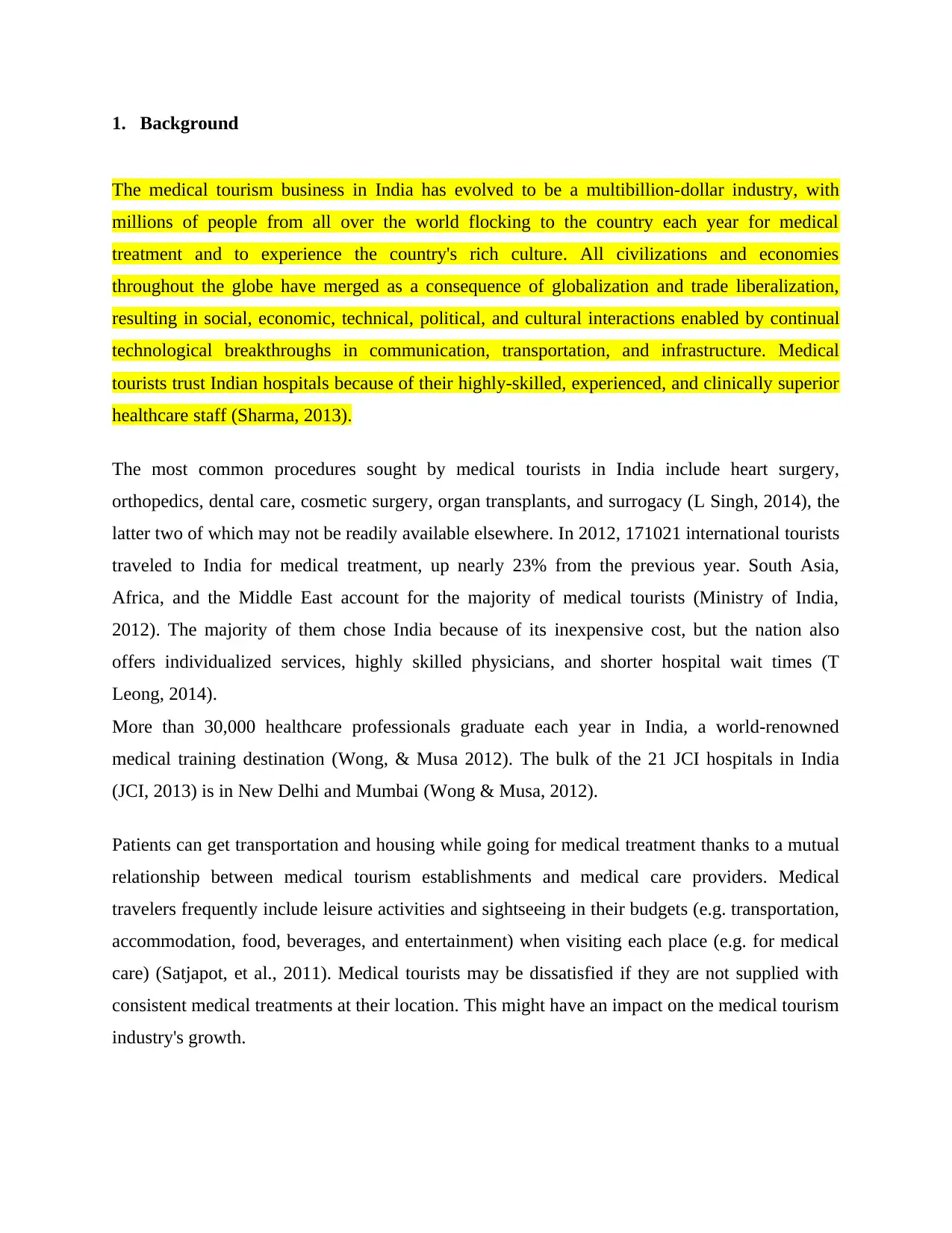
1. Background
The medical tourism business in India has evolved to be a multibillion-dollar industry, with
millions of people from all over the world flocking to the country each year for medical
treatment and to experience the country's rich culture. All civilizations and economies
throughout the globe have merged as a consequence of globalization and trade liberalization,
resulting in social, economic, technical, political, and cultural interactions enabled by continual
technological breakthroughs in communication, transportation, and infrastructure. Medical
tourists trust Indian hospitals because of their highly-skilled, experienced, and clinically superior
healthcare staff (Sharma, 2013).
The most common procedures sought by medical tourists in India include heart surgery,
orthopedics, dental care, cosmetic surgery, organ transplants, and surrogacy (L Singh, 2014), the
latter two of which may not be readily available elsewhere. In 2012, 171021 international tourists
traveled to India for medical treatment, up nearly 23% from the previous year. South Asia,
Africa, and the Middle East account for the majority of medical tourists (Ministry of India,
2012). The majority of them chose India because of its inexpensive cost, but the nation also
offers individualized services, highly skilled physicians, and shorter hospital wait times (T
Leong, 2014).
More than 30,000 healthcare professionals graduate each year in India, a world-renowned
medical training destination (Wong, & Musa 2012). The bulk of the 21 JCI hospitals in India
(JCI, 2013) is in New Delhi and Mumbai (Wong & Musa, 2012).
Patients can get transportation and housing while going for medical treatment thanks to a mutual
relationship between medical tourism establishments and medical care providers. Medical
travelers frequently include leisure activities and sightseeing in their budgets (e.g. transportation,
accommodation, food, beverages, and entertainment) when visiting each place (e.g. for medical
care) (Satjapot, et al., 2011). Medical tourists may be dissatisfied if they are not supplied with
consistent medical treatments at their location. This might have an impact on the medical tourism
industry's growth.
The medical tourism business in India has evolved to be a multibillion-dollar industry, with
millions of people from all over the world flocking to the country each year for medical
treatment and to experience the country's rich culture. All civilizations and economies
throughout the globe have merged as a consequence of globalization and trade liberalization,
resulting in social, economic, technical, political, and cultural interactions enabled by continual
technological breakthroughs in communication, transportation, and infrastructure. Medical
tourists trust Indian hospitals because of their highly-skilled, experienced, and clinically superior
healthcare staff (Sharma, 2013).
The most common procedures sought by medical tourists in India include heart surgery,
orthopedics, dental care, cosmetic surgery, organ transplants, and surrogacy (L Singh, 2014), the
latter two of which may not be readily available elsewhere. In 2012, 171021 international tourists
traveled to India for medical treatment, up nearly 23% from the previous year. South Asia,
Africa, and the Middle East account for the majority of medical tourists (Ministry of India,
2012). The majority of them chose India because of its inexpensive cost, but the nation also
offers individualized services, highly skilled physicians, and shorter hospital wait times (T
Leong, 2014).
More than 30,000 healthcare professionals graduate each year in India, a world-renowned
medical training destination (Wong, & Musa 2012). The bulk of the 21 JCI hospitals in India
(JCI, 2013) is in New Delhi and Mumbai (Wong & Musa, 2012).
Patients can get transportation and housing while going for medical treatment thanks to a mutual
relationship between medical tourism establishments and medical care providers. Medical
travelers frequently include leisure activities and sightseeing in their budgets (e.g. transportation,
accommodation, food, beverages, and entertainment) when visiting each place (e.g. for medical
care) (Satjapot, et al., 2011). Medical tourists may be dissatisfied if they are not supplied with
consistent medical treatments at their location. This might have an impact on the medical tourism
industry's growth.
Paraphrase This Document
Need a fresh take? Get an instant paraphrase of this document with our AI Paraphraser
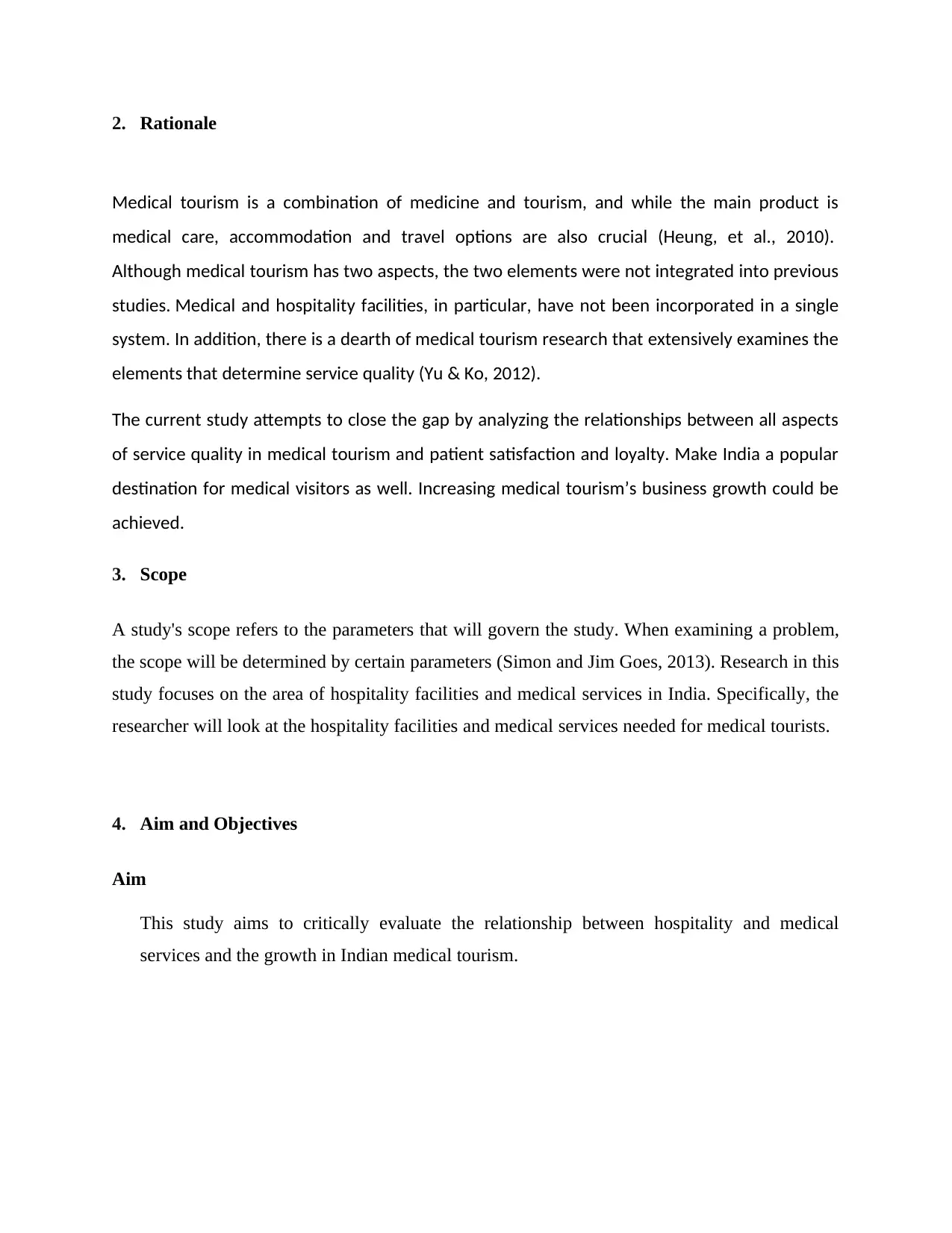
2. Rationale
Medical tourism is a combination of medicine and tourism, and while the main product is
medical care, accommodation and travel options are also crucial (Heung, et al., 2010).
Although medical tourism has two aspects, the two elements were not integrated into previous
studies. Medical and hospitality facilities, in particular, have not been incorporated in a single
system. In addition, there is a dearth of medical tourism research that extensively examines the
elements that determine service quality (Yu & Ko, 2012).
The current study attempts to close the gap by analyzing the relationships between all aspects
of service quality in medical tourism and patient satisfaction and loyalty. Make India a popular
destination for medical visitors as well. Increasing medical tourism’s business growth could be
achieved.
3. Scope
A study's scope refers to the parameters that will govern the study. When examining a problem,
the scope will be determined by certain parameters (Simon and Jim Goes, 2013). Research in this
study focuses on the area of hospitality facilities and medical services in India. Specifically, the
researcher will look at the hospitality facilities and medical services needed for medical tourists.
4. Aim and Objectives
Aim
This study aims to critically evaluate the relationship between hospitality and medical
services and the growth in Indian medical tourism.
Medical tourism is a combination of medicine and tourism, and while the main product is
medical care, accommodation and travel options are also crucial (Heung, et al., 2010).
Although medical tourism has two aspects, the two elements were not integrated into previous
studies. Medical and hospitality facilities, in particular, have not been incorporated in a single
system. In addition, there is a dearth of medical tourism research that extensively examines the
elements that determine service quality (Yu & Ko, 2012).
The current study attempts to close the gap by analyzing the relationships between all aspects
of service quality in medical tourism and patient satisfaction and loyalty. Make India a popular
destination for medical visitors as well. Increasing medical tourism’s business growth could be
achieved.
3. Scope
A study's scope refers to the parameters that will govern the study. When examining a problem,
the scope will be determined by certain parameters (Simon and Jim Goes, 2013). Research in this
study focuses on the area of hospitality facilities and medical services in India. Specifically, the
researcher will look at the hospitality facilities and medical services needed for medical tourists.
4. Aim and Objectives
Aim
This study aims to critically evaluate the relationship between hospitality and medical
services and the growth in Indian medical tourism.
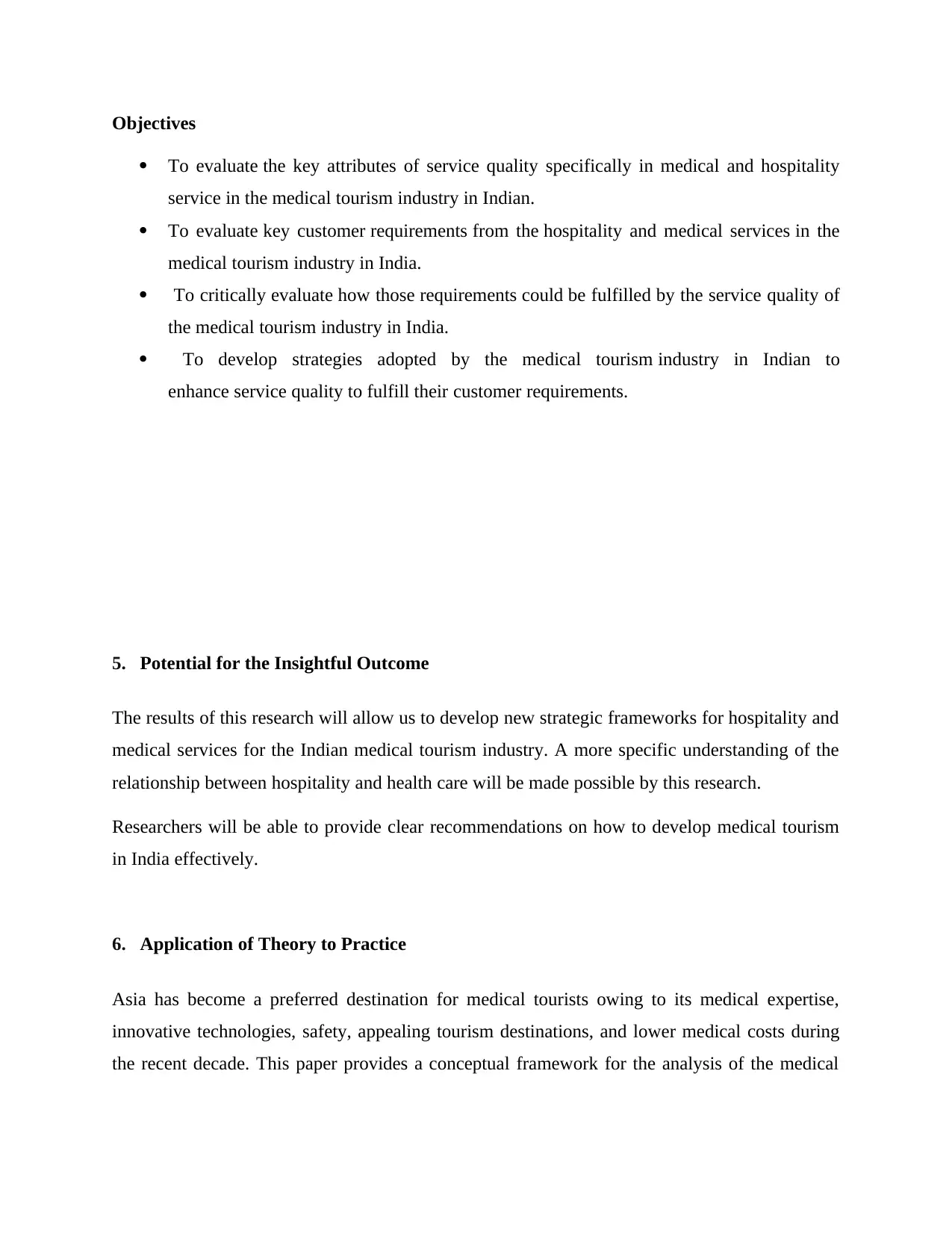
Objectives
To evaluate the key attributes of service quality specifically in medical and hospitality
service in the medical tourism industry in Indian.
To evaluate key customer requirements from the hospitality and medical services in the
medical tourism industry in India.
To critically evaluate how those requirements could be fulfilled by the service quality of
the medical tourism industry in India.
To develop strategies adopted by the medical tourism industry in Indian to
enhance service quality to fulfill their customer requirements.
5. Potential for the Insightful Outcome
The results of this research will allow us to develop new strategic frameworks for hospitality and
medical services for the Indian medical tourism industry. A more specific understanding of the
relationship between hospitality and health care will be made possible by this research.
Researchers will be able to provide clear recommendations on how to develop medical tourism
in India effectively.
6. Application of Theory to Practice
Asia has become a preferred destination for medical tourists owing to its medical expertise,
innovative technologies, safety, appealing tourism destinations, and lower medical costs during
the recent decade. This paper provides a conceptual framework for the analysis of the medical
To evaluate the key attributes of service quality specifically in medical and hospitality
service in the medical tourism industry in Indian.
To evaluate key customer requirements from the hospitality and medical services in the
medical tourism industry in India.
To critically evaluate how those requirements could be fulfilled by the service quality of
the medical tourism industry in India.
To develop strategies adopted by the medical tourism industry in Indian to
enhance service quality to fulfill their customer requirements.
5. Potential for the Insightful Outcome
The results of this research will allow us to develop new strategic frameworks for hospitality and
medical services for the Indian medical tourism industry. A more specific understanding of the
relationship between hospitality and health care will be made possible by this research.
Researchers will be able to provide clear recommendations on how to develop medical tourism
in India effectively.
6. Application of Theory to Practice
Asia has become a preferred destination for medical tourists owing to its medical expertise,
innovative technologies, safety, appealing tourism destinations, and lower medical costs during
the recent decade. This paper provides a conceptual framework for the analysis of the medical
⊘ This is a preview!⊘
Do you want full access?
Subscribe today to unlock all pages.

Trusted by 1+ million students worldwide
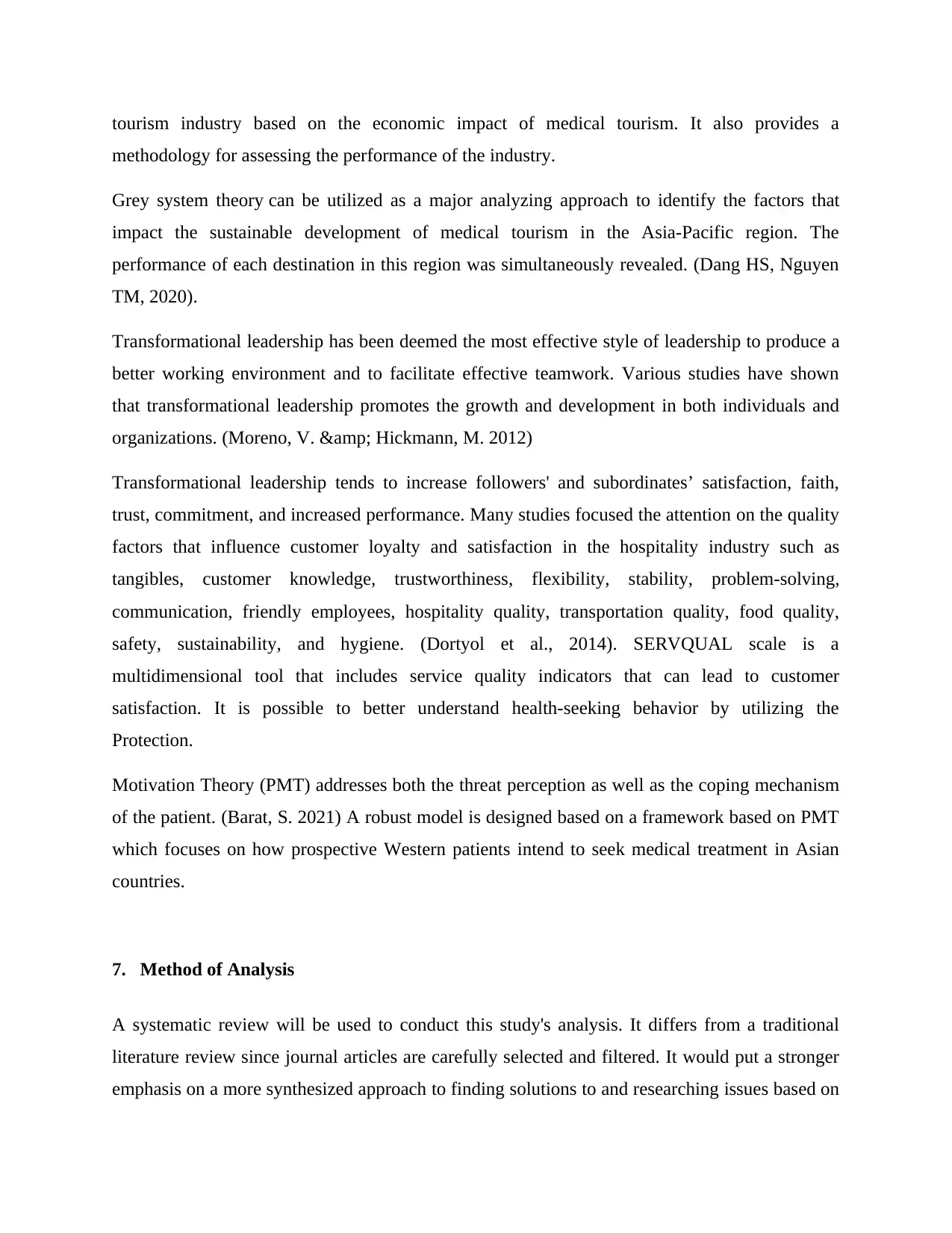
tourism industry based on the economic impact of medical tourism. It also provides a
methodology for assessing the performance of the industry.
Grey system theory can be utilized as a major analyzing approach to identify the factors that
impact the sustainable development of medical tourism in the Asia-Pacific region. The
performance of each destination in this region was simultaneously revealed. (Dang HS, Nguyen
TM, 2020).
Transformational leadership has been deemed the most effective style of leadership to produce a
better working environment and to facilitate effective teamwork. Various studies have shown
that transformational leadership promotes the growth and development in both individuals and
organizations. (Moreno, V. & Hickmann, M. 2012)
Transformational leadership tends to increase followers' and subordinates’ satisfaction, faith,
trust, commitment, and increased performance. Many studies focused the attention on the quality
factors that influence customer loyalty and satisfaction in the hospitality industry such as
tangibles, customer knowledge, trustworthiness, flexibility, stability, problem-solving,
communication, friendly employees, hospitality quality, transportation quality, food quality,
safety, sustainability, and hygiene. (Dortyol et al., 2014). SERVQUAL scale is a
multidimensional tool that includes service quality indicators that can lead to customer
satisfaction. It is possible to better understand health-seeking behavior by utilizing the
Protection.
Motivation Theory (PMT) addresses both the threat perception as well as the coping mechanism
of the patient. (Barat, S. 2021) A robust model is designed based on a framework based on PMT
which focuses on how prospective Western patients intend to seek medical treatment in Asian
countries.
7. Method of Analysis
A systematic review will be used to conduct this study's analysis. It differs from a traditional
literature review since journal articles are carefully selected and filtered. It would put a stronger
emphasis on a more synthesized approach to finding solutions to and researching issues based on
methodology for assessing the performance of the industry.
Grey system theory can be utilized as a major analyzing approach to identify the factors that
impact the sustainable development of medical tourism in the Asia-Pacific region. The
performance of each destination in this region was simultaneously revealed. (Dang HS, Nguyen
TM, 2020).
Transformational leadership has been deemed the most effective style of leadership to produce a
better working environment and to facilitate effective teamwork. Various studies have shown
that transformational leadership promotes the growth and development in both individuals and
organizations. (Moreno, V. & Hickmann, M. 2012)
Transformational leadership tends to increase followers' and subordinates’ satisfaction, faith,
trust, commitment, and increased performance. Many studies focused the attention on the quality
factors that influence customer loyalty and satisfaction in the hospitality industry such as
tangibles, customer knowledge, trustworthiness, flexibility, stability, problem-solving,
communication, friendly employees, hospitality quality, transportation quality, food quality,
safety, sustainability, and hygiene. (Dortyol et al., 2014). SERVQUAL scale is a
multidimensional tool that includes service quality indicators that can lead to customer
satisfaction. It is possible to better understand health-seeking behavior by utilizing the
Protection.
Motivation Theory (PMT) addresses both the threat perception as well as the coping mechanism
of the patient. (Barat, S. 2021) A robust model is designed based on a framework based on PMT
which focuses on how prospective Western patients intend to seek medical treatment in Asian
countries.
7. Method of Analysis
A systematic review will be used to conduct this study's analysis. It differs from a traditional
literature review since journal articles are carefully selected and filtered. It would put a stronger
emphasis on a more synthesized approach to finding solutions to and researching issues based on
Paraphrase This Document
Need a fresh take? Get an instant paraphrase of this document with our AI Paraphraser
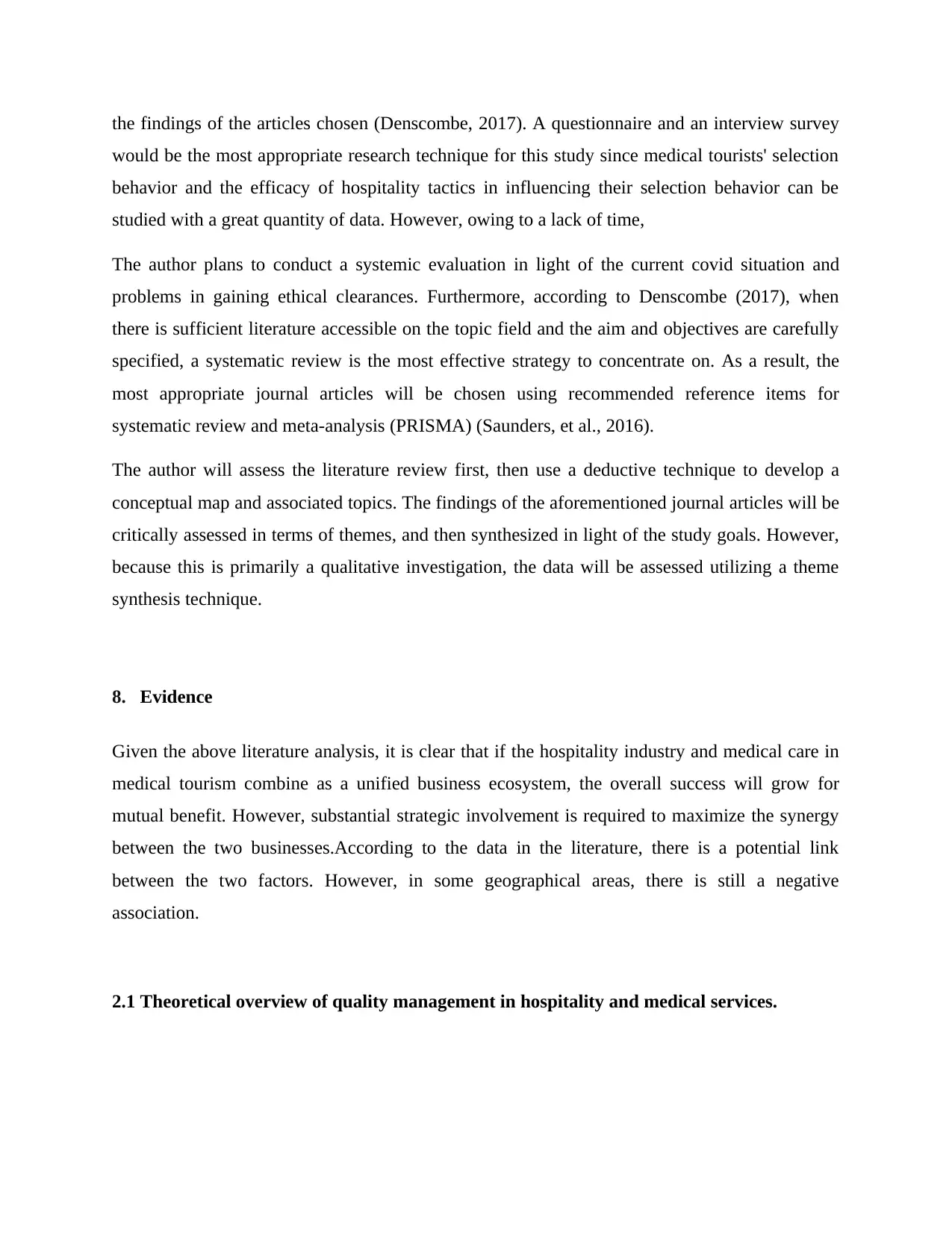
the findings of the articles chosen (Denscombe, 2017). A questionnaire and an interview survey
would be the most appropriate research technique for this study since medical tourists' selection
behavior and the efficacy of hospitality tactics in influencing their selection behavior can be
studied with a great quantity of data. However, owing to a lack of time,
The author plans to conduct a systemic evaluation in light of the current covid situation and
problems in gaining ethical clearances. Furthermore, according to Denscombe (2017), when
there is sufficient literature accessible on the topic field and the aim and objectives are carefully
specified, a systematic review is the most effective strategy to concentrate on. As a result, the
most appropriate journal articles will be chosen using recommended reference items for
systematic review and meta-analysis (PRISMA) (Saunders, et al., 2016).
The author will assess the literature review first, then use a deductive technique to develop a
conceptual map and associated topics. The findings of the aforementioned journal articles will be
critically assessed in terms of themes, and then synthesized in light of the study goals. However,
because this is primarily a qualitative investigation, the data will be assessed utilizing a theme
synthesis technique.
8. Evidence
Given the above literature analysis, it is clear that if the hospitality industry and medical care in
medical tourism combine as a unified business ecosystem, the overall success will grow for
mutual benefit. However, substantial strategic involvement is required to maximize the synergy
between the two businesses.According to the data in the literature, there is a potential link
between the two factors. However, in some geographical areas, there is still a negative
association.
2.1 Theoretical overview of quality management in hospitality and medical services.
would be the most appropriate research technique for this study since medical tourists' selection
behavior and the efficacy of hospitality tactics in influencing their selection behavior can be
studied with a great quantity of data. However, owing to a lack of time,
The author plans to conduct a systemic evaluation in light of the current covid situation and
problems in gaining ethical clearances. Furthermore, according to Denscombe (2017), when
there is sufficient literature accessible on the topic field and the aim and objectives are carefully
specified, a systematic review is the most effective strategy to concentrate on. As a result, the
most appropriate journal articles will be chosen using recommended reference items for
systematic review and meta-analysis (PRISMA) (Saunders, et al., 2016).
The author will assess the literature review first, then use a deductive technique to develop a
conceptual map and associated topics. The findings of the aforementioned journal articles will be
critically assessed in terms of themes, and then synthesized in light of the study goals. However,
because this is primarily a qualitative investigation, the data will be assessed utilizing a theme
synthesis technique.
8. Evidence
Given the above literature analysis, it is clear that if the hospitality industry and medical care in
medical tourism combine as a unified business ecosystem, the overall success will grow for
mutual benefit. However, substantial strategic involvement is required to maximize the synergy
between the two businesses.According to the data in the literature, there is a potential link
between the two factors. However, in some geographical areas, there is still a negative
association.
2.1 Theoretical overview of quality management in hospitality and medical services.
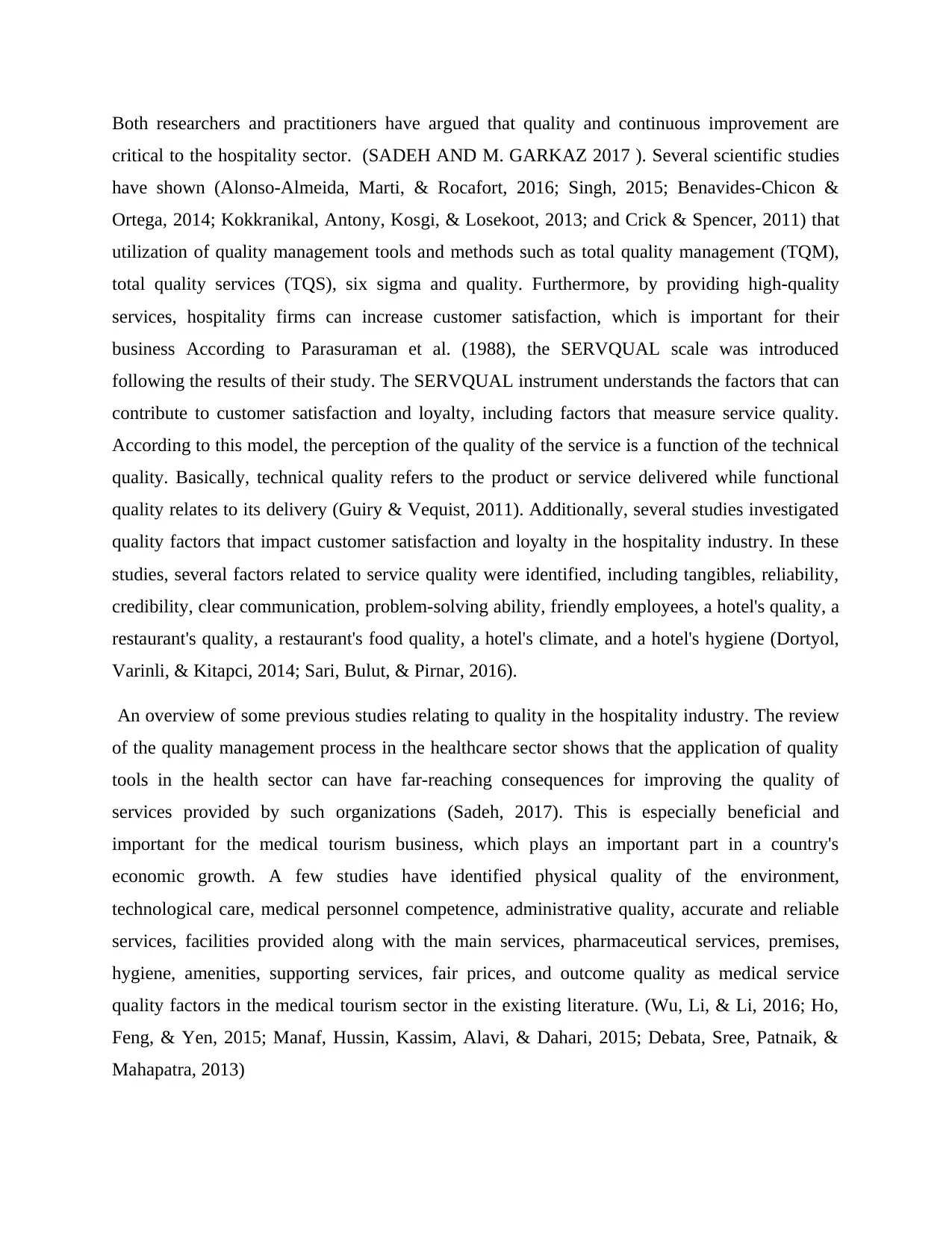
Both researchers and practitioners have argued that quality and continuous improvement are
critical to the hospitality sector. (SADEH AND M. GARKAZ 2017 ). Several scientific studies
have shown (Alonso-Almeida, Marti, & Rocafort, 2016; Singh, 2015; Benavides-Chicon &
Ortega, 2014; Kokkranikal, Antony, Kosgi, & Losekoot, 2013; and Crick & Spencer, 2011) that
utilization of quality management tools and methods such as total quality management (TQM),
total quality services (TQS), six sigma and quality. Furthermore, by providing high-quality
services, hospitality firms can increase customer satisfaction, which is important for their
business According to Parasuraman et al. (1988), the SERVQUAL scale was introduced
following the results of their study. The SERVQUAL instrument understands the factors that can
contribute to customer satisfaction and loyalty, including factors that measure service quality.
According to this model, the perception of the quality of the service is a function of the technical
quality. Basically, technical quality refers to the product or service delivered while functional
quality relates to its delivery (Guiry & Vequist, 2011). Additionally, several studies investigated
quality factors that impact customer satisfaction and loyalty in the hospitality industry. In these
studies, several factors related to service quality were identified, including tangibles, reliability,
credibility, clear communication, problem-solving ability, friendly employees, a hotel's quality, a
restaurant's quality, a restaurant's food quality, a hotel's climate, and a hotel's hygiene (Dortyol,
Varinli, & Kitapci, 2014; Sari, Bulut, & Pirnar, 2016).
An overview of some previous studies relating to quality in the hospitality industry. The review
of the quality management process in the healthcare sector shows that the application of quality
tools in the health sector can have far-reaching consequences for improving the quality of
services provided by such organizations (Sadeh, 2017). This is especially beneficial and
important for the medical tourism business, which plays an important part in a country's
economic growth. A few studies have identified physical quality of the environment,
technological care, medical personnel competence, administrative quality, accurate and reliable
services, facilities provided along with the main services, pharmaceutical services, premises,
hygiene, amenities, supporting services, fair prices, and outcome quality as medical service
quality factors in the medical tourism sector in the existing literature. (Wu, Li, & Li, 2016; Ho,
Feng, & Yen, 2015; Manaf, Hussin, Kassim, Alavi, & Dahari, 2015; Debata, Sree, Patnaik, &
Mahapatra, 2013)
critical to the hospitality sector. (SADEH AND M. GARKAZ 2017 ). Several scientific studies
have shown (Alonso-Almeida, Marti, & Rocafort, 2016; Singh, 2015; Benavides-Chicon &
Ortega, 2014; Kokkranikal, Antony, Kosgi, & Losekoot, 2013; and Crick & Spencer, 2011) that
utilization of quality management tools and methods such as total quality management (TQM),
total quality services (TQS), six sigma and quality. Furthermore, by providing high-quality
services, hospitality firms can increase customer satisfaction, which is important for their
business According to Parasuraman et al. (1988), the SERVQUAL scale was introduced
following the results of their study. The SERVQUAL instrument understands the factors that can
contribute to customer satisfaction and loyalty, including factors that measure service quality.
According to this model, the perception of the quality of the service is a function of the technical
quality. Basically, technical quality refers to the product or service delivered while functional
quality relates to its delivery (Guiry & Vequist, 2011). Additionally, several studies investigated
quality factors that impact customer satisfaction and loyalty in the hospitality industry. In these
studies, several factors related to service quality were identified, including tangibles, reliability,
credibility, clear communication, problem-solving ability, friendly employees, a hotel's quality, a
restaurant's quality, a restaurant's food quality, a hotel's climate, and a hotel's hygiene (Dortyol,
Varinli, & Kitapci, 2014; Sari, Bulut, & Pirnar, 2016).
An overview of some previous studies relating to quality in the hospitality industry. The review
of the quality management process in the healthcare sector shows that the application of quality
tools in the health sector can have far-reaching consequences for improving the quality of
services provided by such organizations (Sadeh, 2017). This is especially beneficial and
important for the medical tourism business, which plays an important part in a country's
economic growth. A few studies have identified physical quality of the environment,
technological care, medical personnel competence, administrative quality, accurate and reliable
services, facilities provided along with the main services, pharmaceutical services, premises,
hygiene, amenities, supporting services, fair prices, and outcome quality as medical service
quality factors in the medical tourism sector in the existing literature. (Wu, Li, & Li, 2016; Ho,
Feng, & Yen, 2015; Manaf, Hussin, Kassim, Alavi, & Dahari, 2015; Debata, Sree, Patnaik, &
Mahapatra, 2013)
⊘ This is a preview!⊘
Do you want full access?
Subscribe today to unlock all pages.

Trusted by 1+ million students worldwide
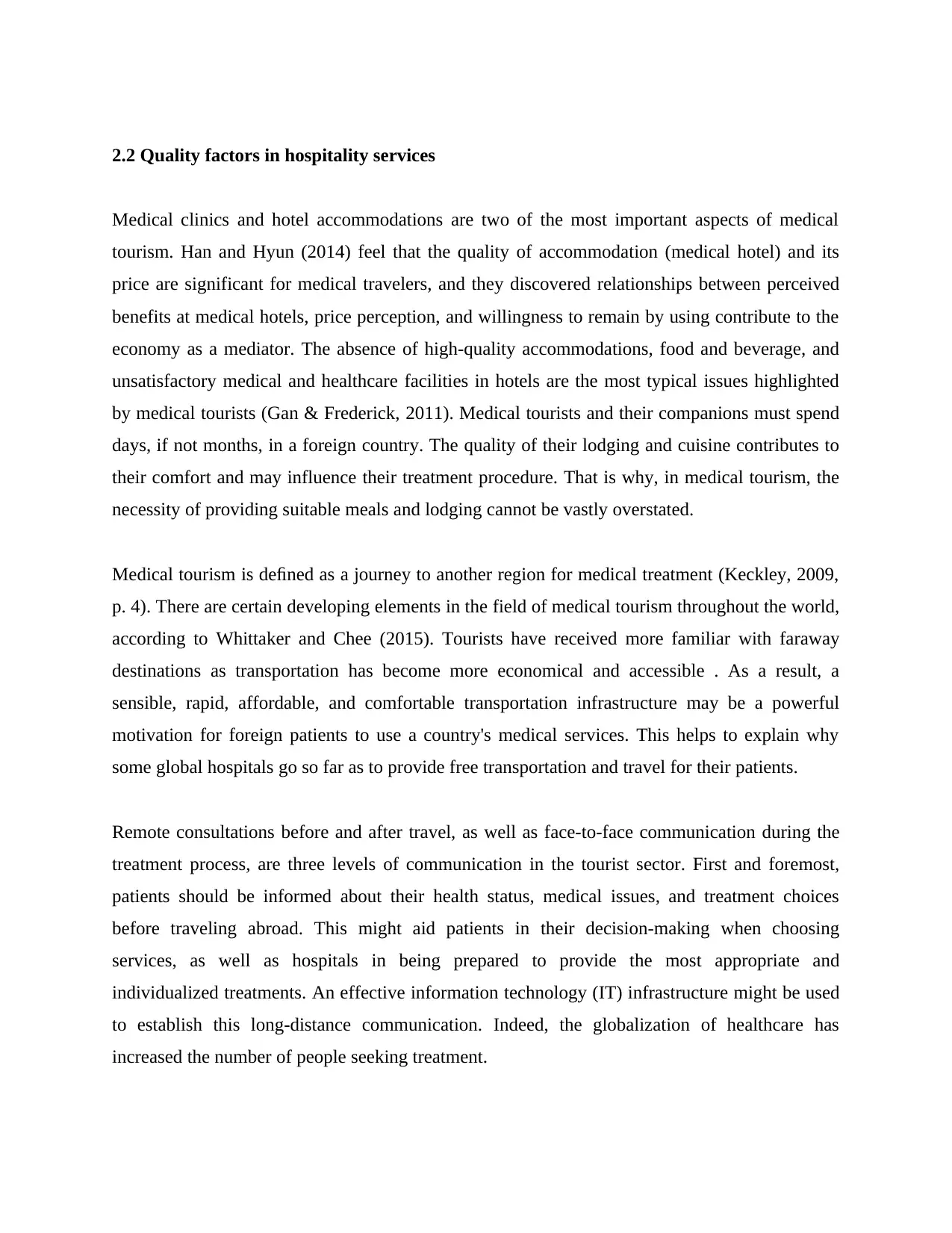
2.2 Quality factors in hospitality services
Medical clinics and hotel accommodations are two of the most important aspects of medical
tourism. Han and Hyun (2014) feel that the quality of accommodation (medical hotel) and its
price are significant for medical travelers, and they discovered relationships between perceived
benefits at medical hotels, price perception, and willingness to remain by using contribute to the
economy as a mediator. The absence of high-quality accommodations, food and beverage, and
unsatisfactory medical and healthcare facilities in hotels are the most typical issues highlighted
by medical tourists (Gan & Frederick, 2011). Medical tourists and their companions must spend
days, if not months, in a foreign country. The quality of their lodging and cuisine contributes to
their comfort and may influence their treatment procedure. That is why, in medical tourism, the
necessity of providing suitable meals and lodging cannot be vastly overstated.
Medical tourism is defined as a journey to another region for medical treatment (Keckley, 2009,
p. 4). There are certain developing elements in the field of medical tourism throughout the world,
according to Whittaker and Chee (2015). Tourists have received more familiar with faraway
destinations as transportation has become more economical and accessible . As a result, a
sensible, rapid, affordable, and comfortable transportation infrastructure may be a powerful
motivation for foreign patients to use a country's medical services. This helps to explain why
some global hospitals go so far as to provide free transportation and travel for their patients.
Remote consultations before and after travel, as well as face-to-face communication during the
treatment process, are three levels of communication in the tourist sector. First and foremost,
patients should be informed about their health status, medical issues, and treatment choices
before traveling abroad. This might aid patients in their decision-making when choosing
services, as well as hospitals in being prepared to provide the most appropriate and
individualized treatments. An effective information technology (IT) infrastructure might be used
to establish this long-distance communication. Indeed, the globalization of healthcare has
increased the number of people seeking treatment.
Medical clinics and hotel accommodations are two of the most important aspects of medical
tourism. Han and Hyun (2014) feel that the quality of accommodation (medical hotel) and its
price are significant for medical travelers, and they discovered relationships between perceived
benefits at medical hotels, price perception, and willingness to remain by using contribute to the
economy as a mediator. The absence of high-quality accommodations, food and beverage, and
unsatisfactory medical and healthcare facilities in hotels are the most typical issues highlighted
by medical tourists (Gan & Frederick, 2011). Medical tourists and their companions must spend
days, if not months, in a foreign country. The quality of their lodging and cuisine contributes to
their comfort and may influence their treatment procedure. That is why, in medical tourism, the
necessity of providing suitable meals and lodging cannot be vastly overstated.
Medical tourism is defined as a journey to another region for medical treatment (Keckley, 2009,
p. 4). There are certain developing elements in the field of medical tourism throughout the world,
according to Whittaker and Chee (2015). Tourists have received more familiar with faraway
destinations as transportation has become more economical and accessible . As a result, a
sensible, rapid, affordable, and comfortable transportation infrastructure may be a powerful
motivation for foreign patients to use a country's medical services. This helps to explain why
some global hospitals go so far as to provide free transportation and travel for their patients.
Remote consultations before and after travel, as well as face-to-face communication during the
treatment process, are three levels of communication in the tourist sector. First and foremost,
patients should be informed about their health status, medical issues, and treatment choices
before traveling abroad. This might aid patients in their decision-making when choosing
services, as well as hospitals in being prepared to provide the most appropriate and
individualized treatments. An effective information technology (IT) infrastructure might be used
to establish this long-distance communication. Indeed, the globalization of healthcare has
increased the number of people seeking treatment.
Paraphrase This Document
Need a fresh take? Get an instant paraphrase of this document with our AI Paraphraser
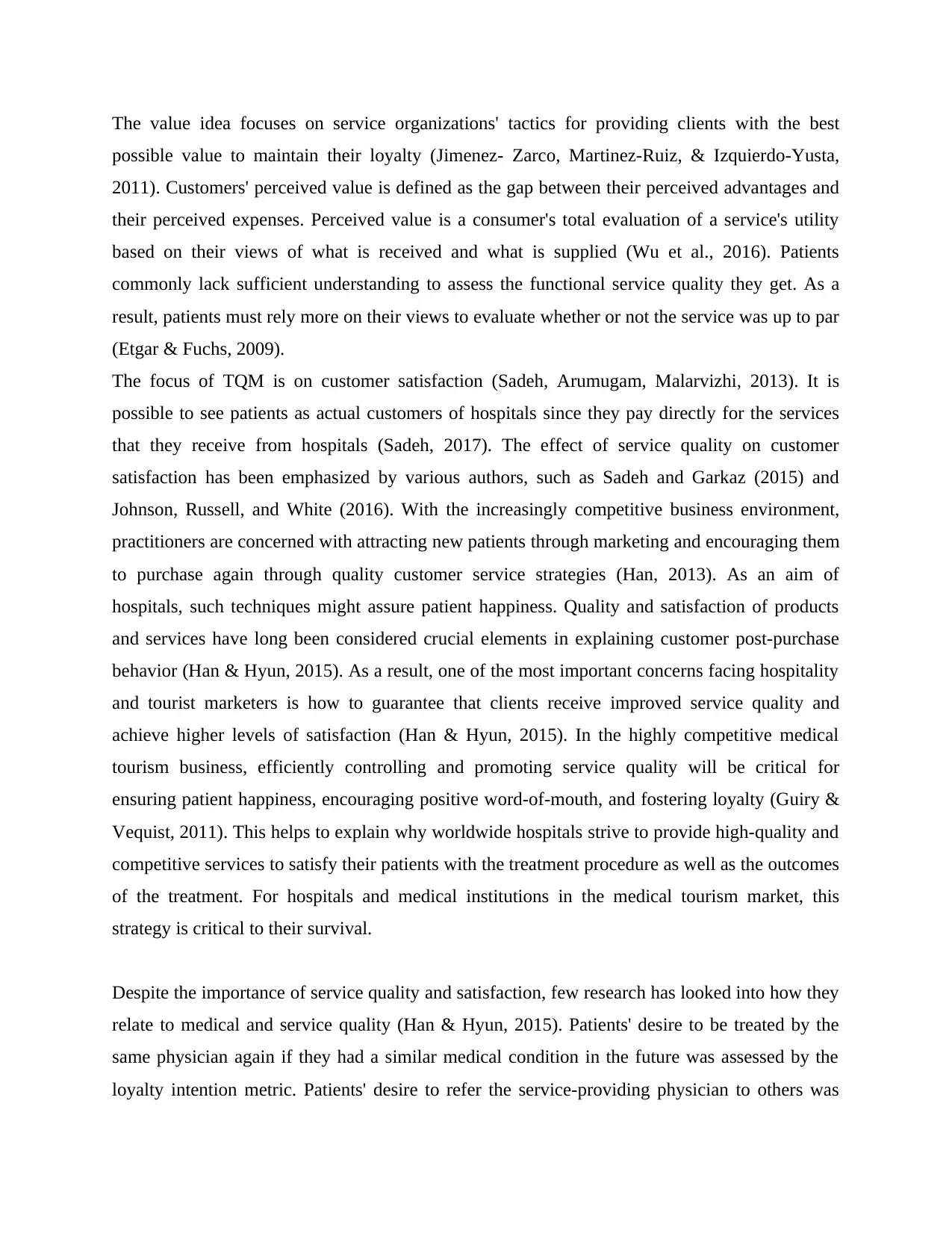
The value idea focuses on service organizations' tactics for providing clients with the best
possible value to maintain their loyalty (Jimenez- Zarco, Martinez-Ruiz, & Izquierdo-Yusta,
2011). Customers' perceived value is defined as the gap between their perceived advantages and
their perceived expenses. Perceived value is a consumer's total evaluation of a service's utility
based on their views of what is received and what is supplied (Wu et al., 2016). Patients
commonly lack sufficient understanding to assess the functional service quality they get. As a
result, patients must rely more on their views to evaluate whether or not the service was up to par
(Etgar & Fuchs, 2009).
The focus of TQM is on customer satisfaction (Sadeh, Arumugam, Malarvizhi, 2013). It is
possible to see patients as actual customers of hospitals since they pay directly for the services
that they receive from hospitals (Sadeh, 2017). The effect of service quality on customer
satisfaction has been emphasized by various authors, such as Sadeh and Garkaz (2015) and
Johnson, Russell, and White (2016). With the increasingly competitive business environment,
practitioners are concerned with attracting new patients through marketing and encouraging them
to purchase again through quality customer service strategies (Han, 2013). As an aim of
hospitals, such techniques might assure patient happiness. Quality and satisfaction of products
and services have long been considered crucial elements in explaining customer post-purchase
behavior (Han & Hyun, 2015). As a result, one of the most important concerns facing hospitality
and tourist marketers is how to guarantee that clients receive improved service quality and
achieve higher levels of satisfaction (Han & Hyun, 2015). In the highly competitive medical
tourism business, efficiently controlling and promoting service quality will be critical for
ensuring patient happiness, encouraging positive word-of-mouth, and fostering loyalty (Guiry &
Vequist, 2011). This helps to explain why worldwide hospitals strive to provide high-quality and
competitive services to satisfy their patients with the treatment procedure as well as the outcomes
of the treatment. For hospitals and medical institutions in the medical tourism market, this
strategy is critical to their survival.
Despite the importance of service quality and satisfaction, few research has looked into how they
relate to medical and service quality (Han & Hyun, 2015). Patients' desire to be treated by the
same physician again if they had a similar medical condition in the future was assessed by the
loyalty intention metric. Patients' desire to refer the service-providing physician to others was
possible value to maintain their loyalty (Jimenez- Zarco, Martinez-Ruiz, & Izquierdo-Yusta,
2011). Customers' perceived value is defined as the gap between their perceived advantages and
their perceived expenses. Perceived value is a consumer's total evaluation of a service's utility
based on their views of what is received and what is supplied (Wu et al., 2016). Patients
commonly lack sufficient understanding to assess the functional service quality they get. As a
result, patients must rely more on their views to evaluate whether or not the service was up to par
(Etgar & Fuchs, 2009).
The focus of TQM is on customer satisfaction (Sadeh, Arumugam, Malarvizhi, 2013). It is
possible to see patients as actual customers of hospitals since they pay directly for the services
that they receive from hospitals (Sadeh, 2017). The effect of service quality on customer
satisfaction has been emphasized by various authors, such as Sadeh and Garkaz (2015) and
Johnson, Russell, and White (2016). With the increasingly competitive business environment,
practitioners are concerned with attracting new patients through marketing and encouraging them
to purchase again through quality customer service strategies (Han, 2013). As an aim of
hospitals, such techniques might assure patient happiness. Quality and satisfaction of products
and services have long been considered crucial elements in explaining customer post-purchase
behavior (Han & Hyun, 2015). As a result, one of the most important concerns facing hospitality
and tourist marketers is how to guarantee that clients receive improved service quality and
achieve higher levels of satisfaction (Han & Hyun, 2015). In the highly competitive medical
tourism business, efficiently controlling and promoting service quality will be critical for
ensuring patient happiness, encouraging positive word-of-mouth, and fostering loyalty (Guiry &
Vequist, 2011). This helps to explain why worldwide hospitals strive to provide high-quality and
competitive services to satisfy their patients with the treatment procedure as well as the outcomes
of the treatment. For hospitals and medical institutions in the medical tourism market, this
strategy is critical to their survival.
Despite the importance of service quality and satisfaction, few research has looked into how they
relate to medical and service quality (Han & Hyun, 2015). Patients' desire to be treated by the
same physician again if they had a similar medical condition in the future was assessed by the
loyalty intention metric. Patients' desire to refer the service-providing physician to others was
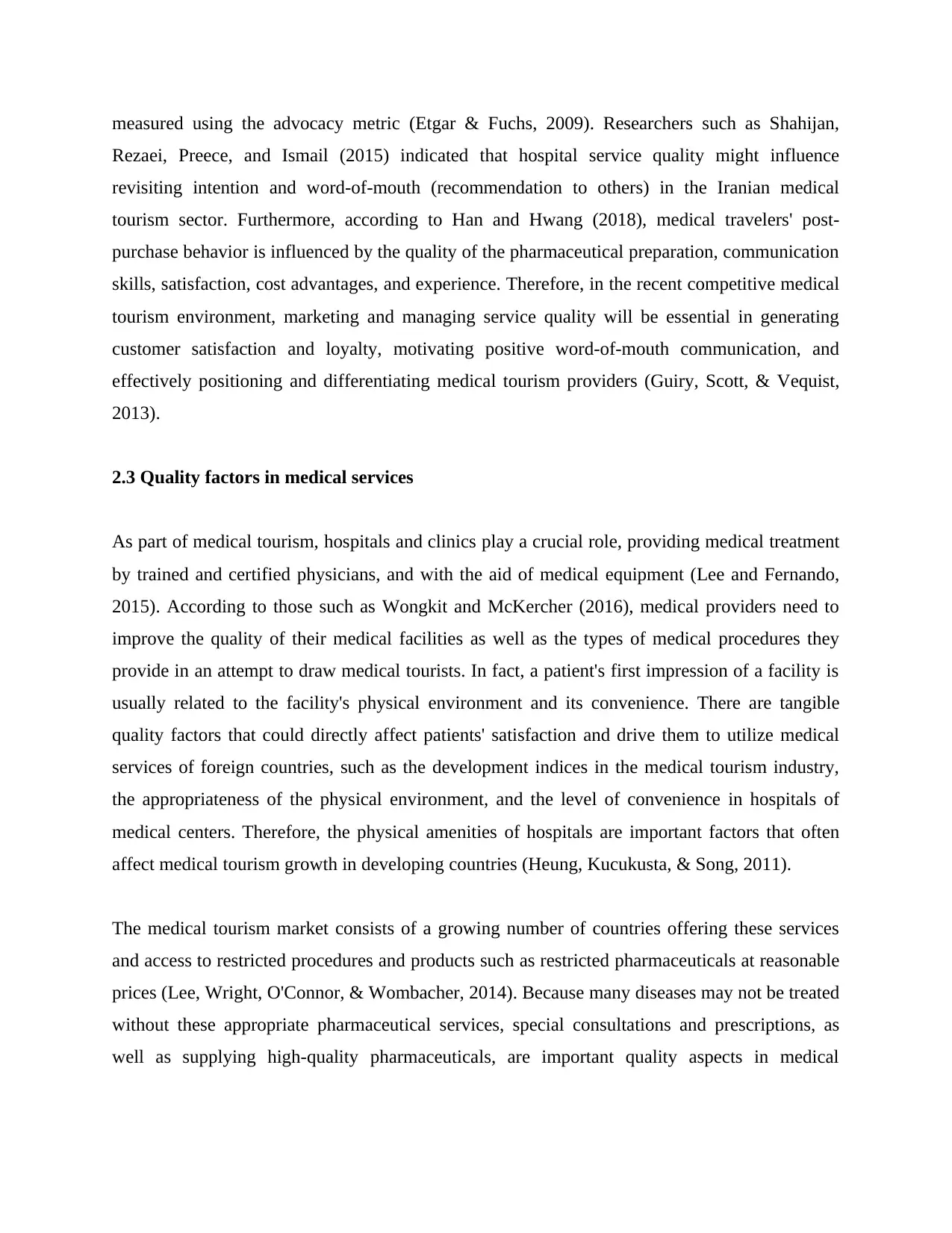
measured using the advocacy metric (Etgar & Fuchs, 2009). Researchers such as Shahijan,
Rezaei, Preece, and Ismail (2015) indicated that hospital service quality might influence
revisiting intention and word-of-mouth (recommendation to others) in the Iranian medical
tourism sector. Furthermore, according to Han and Hwang (2018), medical travelers' post-
purchase behavior is influenced by the quality of the pharmaceutical preparation, communication
skills, satisfaction, cost advantages, and experience. Therefore, in the recent competitive medical
tourism environment, marketing and managing service quality will be essential in generating
customer satisfaction and loyalty, motivating positive word-of-mouth communication, and
effectively positioning and differentiating medical tourism providers (Guiry, Scott, & Vequist,
2013).
2.3 Quality factors in medical services
As part of medical tourism, hospitals and clinics play a crucial role, providing medical treatment
by trained and certified physicians, and with the aid of medical equipment (Lee and Fernando,
2015). According to those such as Wongkit and McKercher (2016), medical providers need to
improve the quality of their medical facilities as well as the types of medical procedures they
provide in an attempt to draw medical tourists. In fact, a patient's first impression of a facility is
usually related to the facility's physical environment and its convenience. There are tangible
quality factors that could directly affect patients' satisfaction and drive them to utilize medical
services of foreign countries, such as the development indices in the medical tourism industry,
the appropriateness of the physical environment, and the level of convenience in hospitals of
medical centers. Therefore, the physical amenities of hospitals are important factors that often
affect medical tourism growth in developing countries (Heung, Kucukusta, & Song, 2011).
The medical tourism market consists of a growing number of countries offering these services
and access to restricted procedures and products such as restricted pharmaceuticals at reasonable
prices (Lee, Wright, O'Connor, & Wombacher, 2014). Because many diseases may not be treated
without these appropriate pharmaceutical services, special consultations and prescriptions, as
well as supplying high-quality pharmaceuticals, are important quality aspects in medical
Rezaei, Preece, and Ismail (2015) indicated that hospital service quality might influence
revisiting intention and word-of-mouth (recommendation to others) in the Iranian medical
tourism sector. Furthermore, according to Han and Hwang (2018), medical travelers' post-
purchase behavior is influenced by the quality of the pharmaceutical preparation, communication
skills, satisfaction, cost advantages, and experience. Therefore, in the recent competitive medical
tourism environment, marketing and managing service quality will be essential in generating
customer satisfaction and loyalty, motivating positive word-of-mouth communication, and
effectively positioning and differentiating medical tourism providers (Guiry, Scott, & Vequist,
2013).
2.3 Quality factors in medical services
As part of medical tourism, hospitals and clinics play a crucial role, providing medical treatment
by trained and certified physicians, and with the aid of medical equipment (Lee and Fernando,
2015). According to those such as Wongkit and McKercher (2016), medical providers need to
improve the quality of their medical facilities as well as the types of medical procedures they
provide in an attempt to draw medical tourists. In fact, a patient's first impression of a facility is
usually related to the facility's physical environment and its convenience. There are tangible
quality factors that could directly affect patients' satisfaction and drive them to utilize medical
services of foreign countries, such as the development indices in the medical tourism industry,
the appropriateness of the physical environment, and the level of convenience in hospitals of
medical centers. Therefore, the physical amenities of hospitals are important factors that often
affect medical tourism growth in developing countries (Heung, Kucukusta, & Song, 2011).
The medical tourism market consists of a growing number of countries offering these services
and access to restricted procedures and products such as restricted pharmaceuticals at reasonable
prices (Lee, Wright, O'Connor, & Wombacher, 2014). Because many diseases may not be treated
without these appropriate pharmaceutical services, special consultations and prescriptions, as
well as supplying high-quality pharmaceuticals, are important quality aspects in medical
⊘ This is a preview!⊘
Do you want full access?
Subscribe today to unlock all pages.

Trusted by 1+ million students worldwide
1 out of 19
Related Documents
Your All-in-One AI-Powered Toolkit for Academic Success.
+13062052269
info@desklib.com
Available 24*7 on WhatsApp / Email
![[object Object]](/_next/static/media/star-bottom.7253800d.svg)
Unlock your academic potential
Copyright © 2020–2025 A2Z Services. All Rights Reserved. Developed and managed by ZUCOL.





